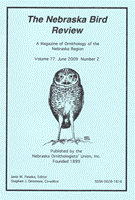Nebraska Ornithologists' Union

Nebraska Bird Review
Date of this Version
3-2020
Document Type
Article
Citation
The Nebraska Bird Review Vol. 88 No. 1, pp. 2-17
Abstract
As with any of these Seasonal Reports, there was plenty to entertain us and to contemplate this winter. The most obvious feature of this winter’s reports was the taxonomically widespread incidence of midwinter occurrences of species normally absent at that time. Snow, Ross’s, and Greater White-fronted Geese occurred in good numbers, and Jan to early Feb reports of dabbling and diving ducks often far from expected winter occurrence locations were notable. Among passerines, notable midwinter reports were of Gray Catbird, Brown Thrasher, and Northern Mockingbird, Nebraska’s first record for Feb of American Pipit, and 6th winter record of Lesser Goldfinch. Both Eastern and Spotted Towhees were more in evidence, as were the icterids Western Meadowlark, Red-winged Blackbird, and Brown-headed Cowbird. Continuing trends of increasing numbers were White-winged Dove, which may be establishing a resident population into winter, and Lesser Black-backed Gull, primarily a migrant, with a vanguard of eight at Lake McConaughy by late Feb. Blackcapped Chickadee and Black-billed Magpie still have population challenges, although the latter shows some encouraging signs. On the other hand, Gray Partridge was unreported. Interesting happenings included a count of as many as 12 Northern Saw-whet Owls in a 2.5-mile stretch of cedar canyon roads in Lincoln County, and four westerly but establishing Barred Owls on the Harlan County Reservoir CBC. Also of interest was the high proportion of “Hepburn’s” Gray-crowned Rosy-Finches in Sioux County, and it was hard to keep track of the Peregrine Falcon musical chairs in North Omaha. Perhaps the most significant rarity was Nebraska’s 4th Yellow-billed Loon, challenged closely by a rather incredible Lewis’s Woodpecker that took up residence in Sarpy County, among all the places it could have chosen closer to home. Only the 3rd Laughing Gull for winter was a rare find. Also unexpected were four each of Northern Goshawks and Barrow’s Goldeneyes, and the reports of three Pine Grosbeaks in Harlan County and a Varied Thrush in Lancaster County.
Included in
Ornithology Commons, Population Biology Commons, Poultry or Avian Science Commons, Zoology Commons


Comments
Published by the Nebraska Ornithologists’ Union, Inc.